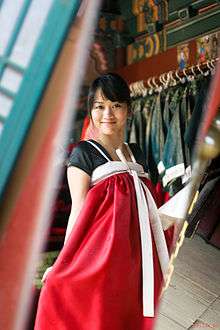Chima (clothing)
Chima is a type of skirt worn together with jeogori, or a short jacket in hanbok, Korean traditional clothing. It is also referred to as sang (裳) or gun (裙) in hanja in the Korean language.[1][2][3]
| Chima | |
 Woman wearing a chima: it is tied just above the breasts | |
| Korean name | |
|---|---|
| Hangul | 치마 |
| Revised Romanization | chima |
| McCune–Reischauer | ch'ima |
History
Basic forms of ancient Chima date back to the Goguryeo kingdom (37 BC-668 AD). The chima is one element of hanbok, which is Korean traditional clothing. It is most commonly worn with the jeogori. While hanbok has evolved overtime, the chima has remained relatively unchanged throughout time.[4] Later on in the Goguryeo Kingdom, the jeogori became shorter and shorter, showing off more of the chima.[5] The use of primary colors in hanbok and more specifically in chima, led to the Korean people often being nicknamed “the white people”.[6] Different colors and lengths indicated important social distinctions such as: age, marital status, and class.
Silhouette
Chima is a floor length wrap around skirt with a wide waistband positioned above the chest. With the high placement of the waistband it allows the skirt to have a more billowy look, which can give greater freedom of movement.[7] Traditionally, women needed to wear about five to seven layers of undergarments which consisted of pants and underskirts, this made the skirt look more voluminous and provide a more elegant look.[8] However, modern women usually wear one layer of undergarment typically pants.
There are different kinds of Chima: single-layered, double-layered, and quilted. Furthermore, Pul-chima refers to a chima with a separated back, whereas a tong-chima has a seamed back.[9] The upper class usually use Ramie as the fabric to make for summer chimas while plain and patterned silks are used throughout the remainder of the year.[10] By contrast, commoners were restricted to using cotton for their chimas.[11] Women in the upper class wore a long chima which falls down to the floor while women in the lower class wore a shorter chima which length reaches to the calf of the leg. Korean noblewomen wore full length chima to designate their social status.
Color
Girls and unmarried women usually wore red skirts, while married women and middle-aged women wore blue skirts and elderly women wore gray skirts.[12] In addition, Goguryeo women also wore saekdong chima that is a colorfully striped skirt by patchworking, and a chima in form of gored skirt, made by sewing several pieces of fabric without gathering.[3]
See also
References
| Wikimedia Commons has media related to Chima. |
- 치마 (in Korean). Nate / Britannica. Retrieved 2013-10-17.
- 치마 (in Korean). Nate / EncyKorea. Retrieved 2013-10-17.
- 치마 (in Korean). Doosan Encyclopedia. Retrieved 2013-10-17.
- Ladner, Mimsie. "Hanbok: An Introduction to South Korea's National Dress". Culture Trip. Retrieved 2019-05-19.
- Service (KOCIS), Korean Culture and Information. "Hanbok: Hidden stories in Hanbok history : Korea.net : The official website of the Republic of Korea". www.korea.net. Retrieved 2019-05-19.
- "韩服_百度百科". wapbaike.baidu.com. Retrieved 2019-05-19.
- Kalbi (2015-02-16). "Hanbok (Korean Traditional Clothing) – A familiar Korean culture symbol". Korean Culture Blog. Retrieved 2019-05-19.
- Kalbi (2015-02-16). "Hanbok (Korean Traditional Clothing) – A familiar Korean culture symbol". Korean Culture Blog. Retrieved 2019-05-19.
- "Korea Information". www.asia-planet.net. Retrieved 2019-05-19.
- "jeogori / chima". British Museum. Retrieved 2019-05-19.
- "jeogori / chima". British Museum. Retrieved 2019-05-19.
- "韩服_百度百科". wapbaike.baidu.com. Retrieved 2019-05-19.